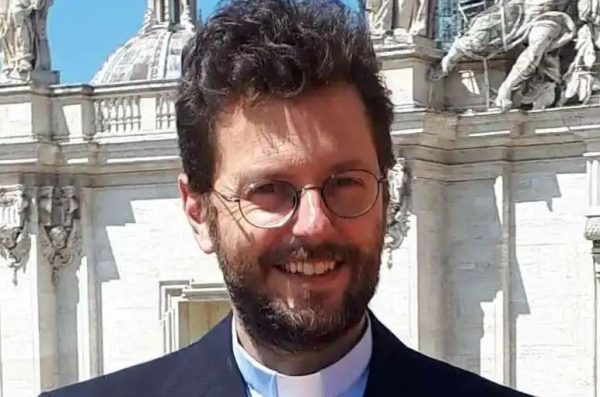Youngest cardinal from Mongolia has vital role to play
June 7, 2022 · By Ben Joseph for www.ucanews.com

Bishop Giorgio Marengo of Ulaanbaatar is to become the youngest cardinal. (Photo: wikipedia.org)
Youngest cardinal from Mongolia has vital role to play
Making someone a prince of the Catholic Church in a sparsely populated Asian country sandwiched between communist China and authoritarian Russia has much to do with faith and pastoral requirements. But its apparent geopolitical expediency cannot be ignored.
By conferring a red hat on 47-year-old Bishop Giorgio Marengo, the apostolic prefect of Ulaanbaatar in Mongolia, 85-year-old Pope Francis has found his youngest cardinal.
Bishop Marengo came to serve Mongolia in 2002, hardly two years after his ordination as a priest. Church records show it is a tiny mission with fewer than 1,300 Catholics in a population of 3.5 million, served by two Mongol priests, 22 foreign missionaries and 35 nuns.
The newest and the first cardinal-elect from the East Asian nation will be eligible to vote in papal conclaves for 33 years. There is a widespread perception among Vatican watchers that this will be Pope Francis’ last addition to the College of Cardinals and, therefore, he wants to put things in a correct perspective.
The pope has started paying attention to the small communities of faithful scattered throughout the world, Italy-born Bishop Marengo said soon after the pope made the announcement of his elevation in St. Peter’s Square.
“… I believe that the pope’s gesture was a missionary gesture, to express attention and care to a small community and to all the small communities of faithful scattered throughout the world, in those lands where they are a small flock,” he said.
Mongolia shares a 4,630-kilometer border with China and shares many cultural aspects with the communist nation’s people. China houses more Mongol people than Mongolia itself
He was referring to the scarce population of Catholics in the difficult terrain of Mongolia, and Catholics in neighboring China and Russia, which have locked horns with the US, the European Union and NATO.
Mongolia may be a democracy but the landlocked Buddhist-majority nation is already a key commodity transit point for the two autocratic regimes.
In the Ukraine conflict, Mongolia, a former Soviet satellite nation until 1990 and dependent on China as a market and conduit for its copper and coal exports, has stayed neutral by refusing to join the US-led NATO coalition against Russia.
Four days after the Russian invasion of Ukraine on Feb. 24, Mongolia signed a memorandum of understanding on the long-planned trans-Mongolian gas pipeline deal that will supply Mongolia with gas from Siberia’s Yamal fields and will allow Russia to transport gas to China.
The EU gets 40 percent of its energy from Russia and is reducing its dependence on it. Mongolia is playing a vital role in finding markets for energy from Russia, which is facing US-led international sanctions.
If the Ukraine conflict is prolonged or if China and Russia form an anti-Western alliance, Mongolia’s political orientation may change once and for all.
That does not mean that the West is deserting Mongolia, three times the size of France with half its population in capital Ulaanbaatar. In May, the UK’s Asia minister of state, Amanda Milling, visited the country to coax it along with the Western discourse.
Mongolia shares a 4,630-kilometer border with China and shares many cultural aspects with the communist nation’s people. China houses more Mongol people than Mongolia itself.
“Dialogue with the Buddhist world, which is a majority in Mongolia, is fundamental for us. It is part of our mission. I am sure it will bear good fruit”
Though the Vatican has inked a secret pact with China on the appointment of bishops, the 2018 deal is believed to have clauses against the Holy See conferring the red hat on prelates living in China.
The Vatican has selected the Catholic leader of Mongolia, which has anthropological ties with China, as its man in the region. In the case of a standoff between China and the West, the Vatican can use the youngest cardinal from Mongolia, a nation that stretches between imposing mountain ranges in the north and arid expanses in the south, as a go-getter.
The appointment also comes as Mongolia observes the 30th anniversary of the rebirth of the Church and the establishment of diplomatic ties with the Holy See. The Church in Mongolia is part of the newly formed Bishops’ Conference of Central Asia.
“Dialogue with the Buddhist world, which is a majority in Mongolia, is fundamental for us. It is part of our mission. I am sure it will bear good fruit,” Bishop Marengo said while leading a Buddhist delegation to Rome at the time of his appointment.
Asia already has 15 cardinal electors. The new consistory will increase Asian representation significantly to 21 with six new cardinals from Asia. Though Africa also had 15 cardinal electors, only two prelates got the red hat this time. In that sense, the pope has put Asia ahead of Africa.
Already the Papa Rosso, or the Red Pope, is from Asia in 64-year-old Cardinal Luis Tagle from the Philippines. His position as head of the Vatican Congregation for the Evangelization of Peoples is second only to the pope.
Cardinal Tagle was last week given the additional charge of heading another important Vatican office — the Congregation for Divine Worship and the Discipline of the Sacraments.
The selection of Bishop Marengo, who has roots in Italy, is a clear sign that the young cardinal is expected to play a vital role in linking the Church in Europe and Asia in more ways than one.
* The views expressed in this article are those of the author and do not necessarily reflect the official editorial position of UCA News.






